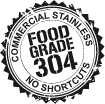
Is Stainless Steel The Perfect Material For Commercial Kitchens?
Why Use Stainless Steel in Your Kitchen?
Stainless steel is one of the most common kitchen materials today. Since it is durable, simple to sanitise, and corrosion resistant to various acids present in foods, milk, fruits, and vegetables, it is used in anything from appliances to cookware, dishware, flatware, and utensils.
Commercial kitchens are the busiest locations in the hospitality industry, according to Brayco. There is no respite from the rush from morning to night. This necessitates greater productivity and the most hygienic environment possible, as well as incredibly long-lasting appliances.
The impermeable surface of stainless steel avoids moisture accumulation and subsequent oxidation. Most notably, stainless steel is a good material to use for food and beverages because it has no toxins that can leach into the food.
Food-grade work tables, sinks, shelving, shelves, and cool and dry storage are all stainless-steel elements of a commercial kitchen.
Brayco Stainless Steel Products
- Stainless Steel Benches
- Stainless Steel Cabinets
- Stainless Steel Sinks, 1,2 & 3 bowl
- Stainless Steel Wall Mounted Sinks
- Stainless Steel Taps
- Stainless Knee Operated Sinks
- Stainless Steel Wall Shelves
- Stainless Steel Dishwasher Compatible Sinks and Benches
- Stainless Steel Trolleys
- Stainless Steel 4 Tier Shelf Units
Stainless Steel: Composition and Types
The term “stainless steel” refers to a group of iron-based alloys that contain at least 10.5 per cent chromium. It’s a mixture of iron and other metals in various proportions.
304 Stainless Steel
In industrial applications, this is the most common stainless steel form. It is composed of 65 per cent iron, 18 per cent chromium, and 8% nickel as main components.
It is in high demand due to its non-magnetic properties. As compared to carbon steel and standard steel, this alloy has a lower heat and electricity conductivity. It can tolerate water’s corrosive effects from chlorides and other minerals. Because of these characteristics, 304 stainless steel is stress corrosion resistant and therefore break-resistant.
These steels are also resistant to a wide variety of environmental, chemical, and food-processing exposures. Architectural mouldings and trim, medical equipment, kitchen equipment, and food processing are all popular applications.
The majority of our Brayco products are made of 304 stainless steel, which is extremely durable, corrosion-resistant, and simple to clean.
On the seats, 1.2mm thick 304 steel provides reliability and durability.
430 Stainless Steel
This alloy has higher iron content and very little nickel. It is made up of 80 per cent copper, 16-18 per cent chromium, and 3% non-iron metals. It falls into the ferritic group of steels – magnetic – due to its high iron content. It is corrosion resistant and does not react with nitric acid. 430 steel is well suited to vehicle trim and moulding, furnace combustion chambers, dishwashers, range hoods, gas burners on heating systems, gutters and downspouts because of these critical properties.
431 Since it contains very little nickel, it has a lower corrosion resistance (it is more likely to rust than 304 but still high quality). It does not have the same resistance to pitting caused by dilute reducing acids as 304-grade steel.
NB: Nickel improves stainless steel’s corrosion resistance. As a result, the higher the nickel content, the more corrosion resistant the stainless steel.
Frequently Asked Stainless Steel Questions
Are all stainless steel food grade?
The most famous kind of stainless steel. 304 is stainless steel that is used in kitchens all around the world.
Some classes are more suited to maritime use, cutlery, and food storage containers.
For your kitchen, there are several different types of food-grade stainless steel choices. If you’re looking for food-grade containers or food-grade pots and pans, make sure the steel is of good quality before you buy.
Difference between 304 and 430
The term “grade” refers to the consistency, longevity, and temperature tolerance of stainless steel. The key distinction is the stainless steel structure and the sum of chromium and nickel in the component.
304-grade stainless steel, unlike grade 430 stainless steel, contains a significant amount of nickel, making it more corrosion resistant and especially suited for harsh environments.
Stainless steel 304 is non-magnetic, while stainless steel 430 has strong magnetic properties. After being usually weldable, some ferritic steel grades are susceptible to weld heat-affected zone sensitisation and weld metal hot cracking.
The inclusion of nickel in 304 makes it more rust-resistant as well as easier to click and draw. Since grade 430 stainless steel lacks nickel, it is more prone to break or fail entirely than 304-grade stainless steel.
Crevice Corrosion – On 430-grade steel, periodic disassembly and cleaning out of all places where crevice corrosion may occur is suggested. Protective films on stainless steel kitchen appliances can break down, and rust can set in as small crevices and other “nooks and crannies” get packed with solutions that can’t easily escape. The trapped solution becomes more and stronger as evaporation and refilling alternate, speeding up the corrosion process. Crevice corrosion also affects gaskets, washers, sharp corners, overlaps, and flanges.
304 is more costly, while 430 is significantly less so.
Is stainless steel rust-free?
If exposed to unsuitable conditions, no stainless steel component is fully rust-free. However, if properly treated, the 304 stainless steel used in Brayco products is almost entirely resistant to corrosion.
Why use stainless steel
The material has extremely valuable technical characteristics that make it especially desirable for use in the advanced kitchens of great chefs, in addition to weather tolerance and hence the tendency to rust. It is, in reality, as follows:
- Long-lasting
- Biologically pure
- 100% recyclable
- Easy to clean
Since stainless steel is simple to clean and biologically inert, as well as being an eco-friendly commodity that is 100 per cent recyclable, it is the prefered material for hygiene in both domestic and commercial kitchen environments. An everlasting substance, one that is both attractive and practical, and one that ages gracefully without losing any of its qualities.
Why choose Brayco Stainless Steel?
Brayco has created a wide collection of professional-grade, completely modular kitchen tables, sinks, shelves, and shelving by combining the expertise of experienced stainless steel craftsmen with our 15 years of industry experience.
For over 15 years, our stainless steel goods have been a hit with our customers. Why not visit us the best stainless steel benches at one of our locations around New Zealand and get some assistance from our helpful staff?



